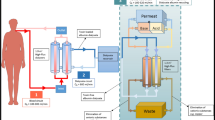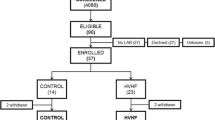Abstract
Objective
Hospital mortality of patients with septic multiorgan failure (MOF) is still around 95%. The present study investigates whether this high mortality could be significantly reduced by the addition of sequential hemofiltration (SH) with bicarbonate hemodialysis (HD) to the currently used life supportive measures.
Design
35 (18 surgical and 17 nonsurgical) patients, with 3 or more organ failures, had daily sessions of zero balance SH, for periods ranging from 2–22 days.
Measurements and results
SH induced significant improvement of PaO2/100 FIO2, Apache II score, MAP, as well as blood chemistry in survivors. Dying patients had less marked improvement of blood oxygenation, non-significant changes in other variables, in addition to low MAP before and after SH, as well as marked hemodynamic unstability during the procedure. The observed hospital motality was 38% for the surgical group, and 35.3% for the medical patients (n.s.).
Conclusions
Mortality observed in this retrospective, uncontrolled study was significantly lower than that currently observed with conventional supportive therapy, with or without the addition of other forms of blood purification, e.g. CAVH and CAVHD. This improvement in results appears to be related to the property of SH to completely clear 90% of the blood from mediators of inflammation in only one passage through the hemofilter, and to better tolerance of HD done using bicarbonate buffer. A definite evaluation of this technique will be eventually reached by a programmed, appropriate sample size study, which is out of reach for one individual ICU.
Similar content being viewed by others
References
Knaus WA, Draper EA, Waner DP, Zimmerman JE (1985) Prognosis in acute organ-system failure. Ann Surg 202:685–692
Tran DD; Groengveld ABJ, Van der Meulen J, Nauta JJP, Van Schijndel RJMS, Thijs LG (1990) Age, chronic renal disease, sepsis, organ system failure, and mortality in a medical intensive care unit. Crit Care Med 18:474–479
Staub NC (1978) Pulmonary edema due to increased microvascular permeability to fluid and protein. Circ Res 43:143–151
Gotloib L, Shostak A, Jaichenko J, Galdi P (1988) Decreased density distribution of mesenteric and diaphragmatic microvascular anionic charges during murine abdominal sepsis. Resuscitation 16:179–192
Gotloib L, Shostak A, Jaichenko J (1989) Loss of mesothelial electronegative fixed charges during murine septic peritonitis. Nephron 51:77–83
Gotloib L, Shostak A, Galdi P, Jaichenko J, Fudin R (1992) Loss of microvascular negative charges accompanied by interstitial edema in septic rats' heart. Circ Shock 36:45–56
Hallgren R, Borg T, Vene P, Modi J (1984) Signs, of neutrophil and eosinophil activation in adult respiratory distress syndrome. Crit Care Med 23:14–18
Trunkey DD (1988) Inflammation and trauma. Arch Surg 123:1517
Hammerschmidt DE, Weaver LJ, Hudson LD, Craddock PR, Jacob HS, (1980) Association of complement activation and elevated plasma-C5a with adult respiratory distress syndrome. Lancet I:947–949
Gotloib L, Barzilay E, Shostak A, Lev A (1984) Sequential hemofiltration in non-oliguric high capillary permeability pulmonary edema of severe sepsis. Preliminary report. Crit Care Med 12:997–1000
Gotloib L, Barzilay E, Shostak A, Waiss Z, Lev A (1985) Hemofiltration in severe septic adult respiratory distress syndrome associated with varicella. Intensive Care Med 11:319–322
Gotloib L, Barzilay E, Shostak A, Waiss Z, Jaichenko J, Lev A (1986) Hemofiltration in septic ARDS. The artificial kidney as an artificial endocrine lung. Resuscitation 13:123–132
Shaldon S, Asaba H, Lindh, Furst P, Larsson LA, Bergstrom J (1978) The technique and application of ultradiffusion (sequential ultrafiltration followed by diffusion). In: Frost TH (ed) Technical aspects of renal dialysis. Pitman Med, London, pp 282–288
Shuster DP, Lefrak SS (1992) Shock. In: Civetta JM, Taylor RW, Kriby RR (eds) Critical care. Lippincott, Philadelphia, pp 407–426
Knaus WA, Draper EA, Wagner DP, Zimmerman JE (1985) Apache II: a severity of disease classification system. Crit Care Med 13:818–829
Craddock PR, Brigham KL, Fehr J (1977) Complement and leukocyte-mediated pulmonary dysfunction in hemodialysis. Eng J Med 296:769–774
Jaichenko J, Shostak A, Abraham D, Gotloib L (1987) Regional heparinization facilitates safe hemodialysis and/or hemofiltration in the critically ill patient. Am J Clin Pathol 87:556–557
Suter PM, Fairlet HB, Isenberg MD (1975) Optimum end-expiratory airway pressure in patients with acute pulmonary failure. N Engl J Med 292:284–289
Chang RWS, Jacobs S, Lee B (1988) Predicting outcome among intensive care unit patients using computerised trend analysis of daily Apache II scores corrected for organ system failure. Intensive Care Med 14:558–566
Bone RC, Fisher CJ, Clemmer TP, Slotman GJ, Metz CA, Balk RA, The Methylpredisolone Severe Sepsis Study Group (1987) A controlled clinical trial of high-dose methylprednisolone in the treatment of severe sepsis and septic shock. N Engl J Med 317:653–658
Schumer W (1976) Steroids in the treatment of clinical septic shock. Ann Surg 184:333–341
Cerra FB, Negro F, Abrams J (1990) Apache II score does not predict multiple organ failure or mortality in postoperative surgical patients. Arch Surg 125:519–522
Hakim RM, Pontzer MA, Tilton D, Lazarus JM, Gottlieb MN (1985) Effects of acetate and bicarbonate dialysate in stable chronic dialysis patients. Kidney Int 28:535–540
Vincent JL, Vankerweghem JL, Degaute JP, Berre J, Dufaye Ph, Kahn RJ (1982) Acetate-induced myocardial depression during hemodialysis for acute renal failure. Kidney Int 22:653–657
Zucchelli P, Santoro A (1993) Correction of acid-base balance by dialysis. Kidney Int [Suppl]41:S179-S183
Pine RW, Wertz MJ, Lennard ES, Dellinger EP, Carrico CJ, Minshev BH (1983) Determinants of organ malfunction or death in patients with intraabdominal sepsis. Arch Surg 118:242–249
Giroir BP (1993) Mediators of septic shock: new approaches for interrupting the endogenous inflammatory cascade. Crit Care Med 21:780–789
Gotloib L, Shostak A, Jaichenko J, Galdi P (1988) Decreased density distribution of mesenteric and diaphragmatic microvascular anionic charges during murine abdominal sepsis. Resuscitation 16:179–192
Gotloib L, Shostak A, Galdi P, Jaichenko J, Fudin R (1992) Loss of microvascular negative charges accompanied by interstitial edema in septic rats heart. Circ Shock 36:45–46
Gotloib L, Shostak A (1992) Lessons of peritoneal ultrastructure: from an inert dialyzing sheet to a living membrane. In: Berlyne GM (ed) The kidney today. Selected topics in renal science. Karger, Basel, pp 207–235
Gillis CN, Pitt BR (1982) The fate of circulating amines within the pulmonary circulation. Ann Rev Physiol 44:269–281
Mackersie RC, Christensen J, Lewis FR, (1987) The role of pulmonary lymphatics in the clearance of hydrostatic pulmonary edema. J Surg Res 43:495–504
Weiss L, Danielson BG, Wikstrom B, Hedstrand U, Wahlberg J (1989) Continuous arteriovenous hemofiltration in the treatment of 100 critically ill patients with acute renal failure: report on clinical outcome and nutritional aspects. Clin Nephrol 31:184–189
Ronco C, Brendolani A, Bragantini l, Chiaramonte S, Feriani M, Fabris A, Dell'Aquila R, La Greca G, Milan M (1988) Continuous arteriovenous hemofiltration with AN 69S membrane; procedures and experience. Kidney Int 33: [Suppl 24]:S150-S153
Schneider NS, Geronemus RP (1988) Continuous arteriovenous hemodialysis. Kidney Int 33 [Suppl 24]:S149/S162
Duwe AK, Vas SI, Wetherhead JW (1981) Effects of the composition of peritoneal dialysis fluid on chemiluminiscence, phagocytosis, and bactericidal activity in vitro. Infect Immun 33:130–135
Bagshaw ONT, Andes FRC, Hutchinson A (1992) Continuous arteriovenous haemofiltration and respiratory function in multiple organ systems failure Intensive Care Med 18:334–338
Henderson IS, Couper IA, Lumsden A (1986) Potentially irritant glucose metabolites in unused CAPD fluid. In: Maher JF, Winchester JF (eds) Frontiers in peritoneal dialysis. Field, Rich and Assoc, New York, pp 261–264
Barzilay E, Kessler D, Berlot G, Gullo A, Geber D, Ben-Zeev I (1989) Use of extracorporeal supportive techniques as additional treatment for septic induced multiple organ failure patients. Crit Care Med 17:634–637
Bellomo R, Parkin G, Love J, Boyce N (1993) A prospective comparative study of continuous arteriovenous hemodiafiltration and continuous venovenous hemodiafiltration in critically ill patients. Am J Kidney Dis 21:508–518
Author information
Authors and Affiliations
Rights and permissions
About this article
Cite this article
Gotloib, L., Shostak, A., Lev, A. et al. Treatment of surgical and non-surgical septic multiorgan failure with bicarbonate hemodialysis and sequential hemofiltration. Intensive Care Med 21, 104–111 (1995). https://doi.org/10.1007/BF01726531
Received:
Accepted:
Issue Date:
DOI: https://doi.org/10.1007/BF01726531




